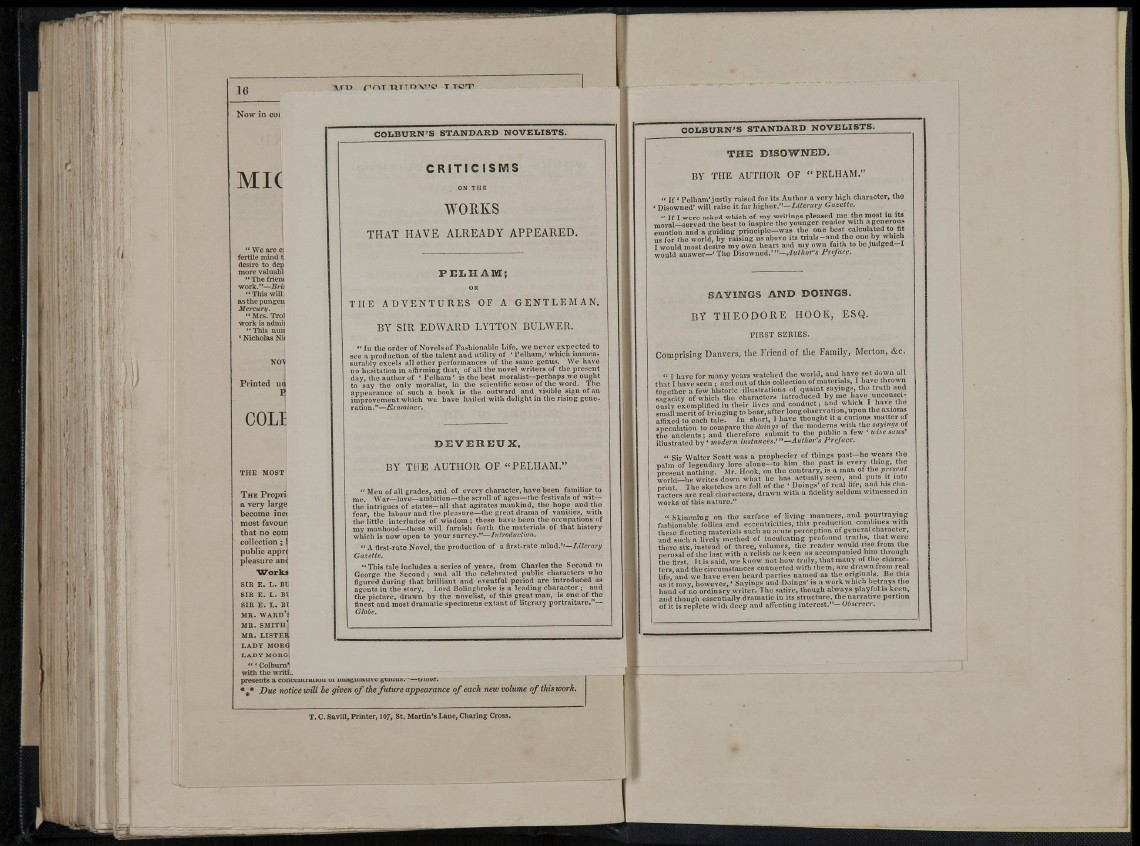
i i í ' ¡i"
K -I'
'f ;
í ' lìì;
.i;
i\fimi:!:m)^
i i i '
16 1\yTT> POT TlTTO-\T>C? T TGT
MI(
" We are e:
fertile mind t
desire to dep
more valuabl
" The frien<
•work."—BnV
" This vnll
asthepimgen
Alercurt/.
" Mrs. Trol
work is admii
" This nun
' Nicholas Ni«
Printed un
P
COLI
THE MOST
The Propri,
a very large
become inc<
most favour
that no com
collection ; t
public appr<
pleasure anc
WorSLS
SIR E. L. BZ
SIR E. L. Bl
SIR E. L. Bt
MR. WARD'S
ME. SMITH'
MR. LISTER
LADY Moaa
LADYMORG,
" ' Colbum'i
with the writì-.
presents a
*J* Due notice will I
COLBURN'S STANDARD NOVEIiISTS.
C R I T I C I S W I S
ON THE
WORKS
THAT HAVE ALREADY APPEARED.
P E L H A M ;
T H E ADVENTURES OF A GENTLEMAN.
B Y SIR E DWA l l D LYTTON BULWER.
" la the order of Novels of Fasliion.ible Life, we never expected to
SCO a production of tile talent and utility of ' i'elham,' whieli imaiea.
Bunabiy csceis all other performances of ttie same genus. We have
no hesitation in affirniing that, of all the novel writers of the present
day. the author of ' Peiham' is the hest moralist—perhaps we ought
to say the only moralist, in the scientific sense of the word. The
appearance of such a book is tiie outward and visilde sign of an
improvement which wt have hailed with delight in the rising gene •
ration."—jKra;«i)iifj-.
D E V E H E U X .
BY THE AUTHOR OF "PELHAM."
" Men of all grades, and of every character, have been familiar to
me War—love—ambition—the scroll of ages—the festivals of wit—
the intrigues of states—all that agitates inanitind. the liope and the
fear, the labour and the pleasure—the great drama of vanilies. with
the little interludes of wisdom ; these tiave been the occupations of
my manhood—these will furnish forth the materials of that history
which is now open to your survey."—hitmluction.
" A first-rate Novel, the production of a first-rate mind.''—iiierary
Gazette.
" This t.ale includes a series of years, from Charles the Second to
George the Kecond; and all the celebrated public characters who
figured during that brilliant and eventful period are introduced as
agents in the story. Lord BolioRbroke is a leading character ; and
the picture, drawn by the novelist, of this great man, is one of the
finest and most dramatic specimens extant of literary portraiture."—
Globe.
ui nuaguiauve gcmus.-•—\iWoe.
given of th£ future appearance of each new volume of this work.
T. C. Savi», Printer, 107, St. Martin's Lane, Charing Cross.
OOLBOKN'S STANDARD NOVEI.ISTS.
T H E DISOWNED.
BY TIIE AUTHOR OF " PELHAM."
" If • Pelham'justly raised for its Author a very high char.acter, the
' Disowned' will raise it far higher."-Mierorj/ Gazette.
" If I were asked which of my writings pleased me the most in its
moral-served tho best to inspire the yoimger reader with a generous
S o t l o n and a guiding principle-was the one be» calculated to fit
us for the world, by raising us .above .ts t n a l s - a n d the one by which
1 would most desire my own heart and my own faith to bejudged- l
would answer-'The Disowned."'-.il<I/ior'« frejace.
SAYINGS A N D DOINGS.
BY THEODORE HOOK, ESQ.
riBST SERIES.
Coinin-ising Danveis, tliE Friend of llie Family, Meiton, &c.
•' I have for many years watched the world, and have set down all
that I have seen, aid out of this oolleotion of materials, I have i irown
together a few historic illustraliou. of quaint sayings, the truth and
saScity of which the characters Introduced by me have unconseioSly
eLmplified in their lives and conduct, and which I have the
small merit bf bringing to hoar, after longobservation,upon the axioms
nffiied to each tale, in short, 1 have thought it a curious matter of
™eo»Tation 5o eimpare the tloiiys of the moderi.s will, ihe say,,,,, of
« i l Kicients : and therefore submit to the public a few ' wtte »«!»«'
illustrated by ' modern instances.——Att/wr's Prejiice.
" Sir Walter Scott was a prophecier of things past—be wears the
palm of legendary lore alone-to him tho past is every thing, the
present nothing. .Mr. Hook, on the contrary, is a man of the p,e.e«l
world-he writes down what ho has act.ially seen, and puts it into
prin The sketclies are full of the ' Doings' of real lile, aud liis c. laiaeters
are real characters, drawn with a fidelity seldom witnessed in
works of tiiis "
" Skiminhiii on the surfacc of living manners, and pourtraying
fasiiionable lollies and eccentricities, this production combmes with
these Heeling materials such an ac.iite perception of general character,
aud such a lively method of inculcating profound truths, that were
there six, instead of three^ Tolumea, the reader would nse Irom tlie
nerusal of Ihe last with a relish aa keen as acccuipanied hnn through
the first r t is said, we know not how truly, that many ot the characters.
_
and the circumstances connected with ihcm, are drawn from real
lift' and we have eveo heard parties named aa the originals, lie this
as it may. however,' Sayings and Doings' is a work, which betrays the
hand of no ordinary writer. Tho satire, though always playful is keen,
and though essentially dramatic in its structure, the narratiTe poruoa
of it is replete wich deep and aCFecting interest."—Oweruer.